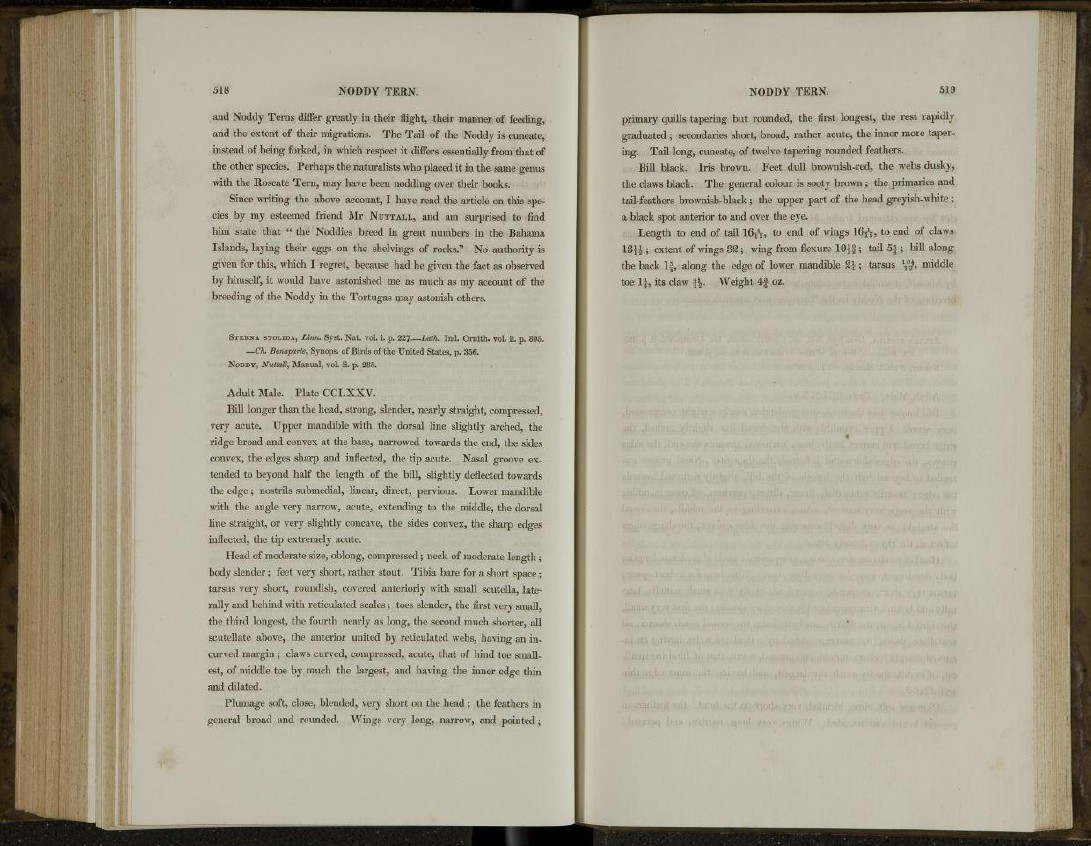
518 NODDY TERN.
and Noddy Terns differ greatly in their flight, their manner of feeding,
and the extent of their migrations. The Tail of the Noddy is cuneate,
instead of being forked, in which respect it differs essentially from that of
the other species. Perhaps the naturalists who placed it in the same genus
with the Roseate Tern, may have been nodding over their books.
Since writing the above account, I have read the article on this species
by my esteemed friend Mr NUTTALL, and am surprised to find
him state that " the Noddies breed in great numbers in the Bahama
Islands, laying their eggs on the shelvings of rocks.11 No authority is
given for this, which I regret, because had he given the fact as observed
by himself, it would have astonished me as much as my account of the
breeding of the Noddy in the Tortugas may astonish others.
STERNA STOLIDA, Linn, Syst. Nat. vol. i. p. 227.—Lath. Ind. Ornith. vol. ii. p. 805.
—Ch. Bonaparte, Synops. of Birds of the United States, p. 356.
NODDY, Nuttall, Manual, vol. ii. p. 285.
Adult Male. Plate CCLXXV.
Bill longer than the head, strong, slender, nearly straight, compressed,
very acute. Upper mandible with the dorsal line slightly arched, the
ridge broad and convex at the base, narrowed towards the end, the sides
convex, the edges sharp and inflected, the tip acute. Nasal groove extended
to beyond half the length of the bill, slightly deflected towards
the edge ; nostrils submedial, linear, direct, pervious. Lower mandible
with the angle very narrow, acute, extending to the middle, the dorsal
line straight, or very slightly concave, the sides convex, the sharp edges
inflected, the tip extremely acute.
Head of moderate size, oblong, compressed; neck of moderate length;
body slender; feet very short, rather stout. Tibia bare for a short space;
tarsus very short, roundish, covered anteriorly with small scutella, laterally
and behind with reticulated scales; toes slender, the first very small,
the third longest, the fourth nearly as long, the second much shorter, all
scutellate above, the anterior united by reticulated webs, having an incurved
margin ; claws curved, compressed, acute, that of hind toe smallest,
of middle toe by much the largest, and having the inner edge thin
and dilated.
Plumage soft, close, blended, very short on the head; the feathers in
general broad and rounded. Wings very long, narrow, and pointed;
NODDY TERN. 519
primary quills tapering but rounded, the first longest, the rest rapidly
graduated; secondaries short, broad, rather acute, the inner more tapering.
Tail long, cuneate, of twelve tapering rounded feathers.
Bill black. Iris brown. Feet dull brownish-red, the webs dusky,
the claws black. The general colour is sooty brown ; the primaries and
tail-feathers brownish-black ; the upper part of the head greyish-white ;
a black spot anterior to and over the eye.
Length to end of tail 16^, to end of wings 16rV> to end of claws
13H ; extent of wings 32; wing from flexure \0\%; tail 5f ; bill along
the back If, along the edge of lower mandible 2\; tarsus middle
toe 1£, its claw f£. Weight 4f oz.